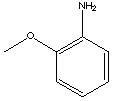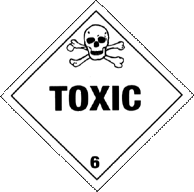o-Anisidine
- 2-Methoxybenzenamine
- o-Methoxyaniline
- 2-Methoxyaniline
- 2-Aminoanisole

o-Anisidine | |
| |
| Formula | 2-(CH3O)C6H4NH2 |
| Structure |  |
| Description | Red or yellow oily liquid with an amine-like odor becomes brownish on exposure to air. |
| Uses | Intermediate in the manufacturing of dyes, pharmaceuticals, and fragrances. |
| Registry Numbers and Inventories. | |
| CAS | 90-04-0 |
| EC (EINECS/ELINCS) | 201-963-1 |
| EC Index Number | 612-035-00-4 |
| EC Class | Carcinogenic Category 2; Mutagenic Category 3; Toxic |
| EC Risk Phrase | R 45 68 23/24/25 |
| EC Safety Phrase | S 53 45 |
| RTECS | BZ5410000 |
| RTECS class | Tumorigen; Mutagen |
| UN (DOT) | 2431 |
| Merck | 13,670 |
| Beilstein/Gmelin | 386210 |
| Beilstein Reference | 4-13-00-00806 |
| Swiss Giftliste 1 | G-1134 |
| Canada DSL/NDSL | DSL |
| US TSCA | Listed |
| Austrailia AICS | Listed |
| New Zealand | Listed |
| Japan ENCS (MITI) | Listed |
| Korea ECL | Listed |
| Properties. | |
| Formula | C7H9NO |
| Formula mass | 123.16 |
| Melting point, °C | 5 |
| Boiling point, °C | 225 |
| Vapor pressure, mmHg | 0.09 (25 C) |
| Vapor density (air=1) | 4.25 |
| Saturation Concentration | 131.6 ppm (0.013%) at 27 C (calculated) |
| Critical temperature | 455 |
| Critical pressure | 42.0 |
| Density | 0.966 g/cm3 (13 C) |
| Solubility in water | Slightly soluble |
| Viscosity | 2.21 cp (55 C) |
| Surface tension | 44.01 g/s2 (20 C) |
| Refractive index | 1.5688 (20 C) |
| pKa/pKb | 9.48 (pKb6 |
| Partition coefficient, pKow | 1.18 |
| Heat of vaporization | 46.2 kJ/mol |
| Heat of combustion | -3995 kJ/mol |
| Hazards and Protection. | |
| Storage | Store in a cool, dry place. Store in a tightly closed container. |
| Handling | Wash thoroughly after handling. Remove contaminated clothing and wash before reuse. Use only in a well ventilated area. Do not get on skin or in eyes. Do not ingest or inhale. |
| Protection | Eyes: Wear safety glasses and chemical goggles if splashing is possible. Wear appropriate protective eyeglasses or chemical safety goggles as described by OSHA's eye and face protection regulations in 29 CFR 1910.133 or European Standard EN166. Skin: Wear appropriate protective gloves and clothing to prevent skin exposure. Wear appropriate gloves to prevent skin exposure. Clothing: Wear appropriate protective clothing to minimize contact with skin. |
| Respirators | Wear a NIOSH/MSHA or European Standard EN 149 approved full-facepiece airline respirator in the positive pressure mode with emergency escape provisions. Follow the OSHA respirator regulations found in 29CFR 1910.134 or European Standard EN 149. Always use a NIOSH or European Standard EN 149 approved respirator when necessary. |
| Small spills/leaks | Absorb spill with inert material, (e.g., dry sand or earth), then place into a chemical waste container. |
| Disposal code | 9 |
| Stability | Stable under normal temperatures and pressures. |
| Incompatibilities | Strong oxidizing agents. |
| Decomposition | Nitrogen oxides, carbon monoxide, carbon dioxide, nitrogen. |
| Fire. | ||||
| Flash Point,°C | 100 | |||
| Autoignition, °C | 437 | |||
| Fire fighting | Wear a self-contained breathing apparatus in pressure-demand, MSHA/NIOSH (approved or equivalent), and full protective gear. To extinguish fire, use water, dry chemical, chemical foam, or alcohol-resistant foam. | |||
| Fire potential | This chemical is combustible. | |||
| Hazards | When heated, vapors may form explosive mixtures with air: indoors, outdoors, and sewers explosion hazards. | |||
| Combustion products | Fire may produce irritating, corrosive and/or toxic gases. | |||
| NFPA | Health | 2 | ||
| Flammability | 1 | |||
| Reactivity | 0 | |||
| Health. | |
| Exposure limit(s) | NIOSH REL: Ca 0.5 mg/m3 skin See Appendix A NIOSH IDLH: Potential occupational carcinogen 50 mg/m3 |
| Carcinogin | G-A3, I-2B, CP65 |
| Poison_Class | 1* |
| Exposure effects | May cause cancer according to animal studies. |
| Ingestion | May cause irritation of the digestive tract. May cause kidney damage. May cause methemoglobinemia, cyanosis, convulsions, and death. Methemoglobinemia is characterized by dizziness, drowsiness, headache, breath shortness, cyanosis with bluish skin, rapid heart rate and chocolate-brown colored blood. |
| Inhalation | May cause severe allergic respiratory reaction. May cause respiratory tract irritation. |
| Skin | May be absorbed through the skin in harmful amounts. May cause skin sensitization, an allergic reaction, which becomes evident upon re-exposure to this material. If absorbed, may cause symptoms similar to those for ingestion. |
| Eyes | Causes severe eye irritation. |
First aid |
|
| Ingestion | If victim is conscious and alert, give 2-4 cupfuls of milk or water. Get medical aid immediately. Do NOT induce vomiting. If conscious and alert, rinse mouth and drink 2-4 cupfuls of milk or water. |
| Inhalation | Get medical aid immediately. Remove from exposure to fresh air immediately. If breathing is difficult, give oxygen. |
| Skin | Flush skin with plenty of soap and water for at least 15 minutes while removing contaminated clothing and shoes. Get medical aid if symptoms occur. |
| Eyes | Flush eyes with plenty of water for at least 15 minutes, occasionally lifting the upper and lower eyelids. Immediately flush eyes with plenty of water for at least 15 minutes, occasionally lifting the upper and lower eyelids. Get medical aid immediately. |
| Transport. | ||
| UN number | 2431 |  |
| Response guide | 153 | |
| Hazard class | 6.1 | |
| Packing Group | III | |
| USCG CHRIS Code | ADO | |
| HS Code | 2922 22 00 | |